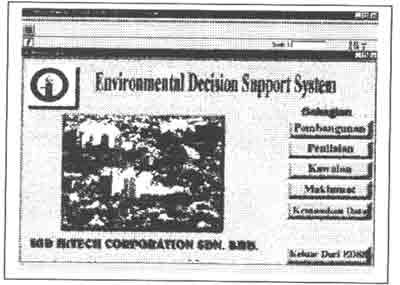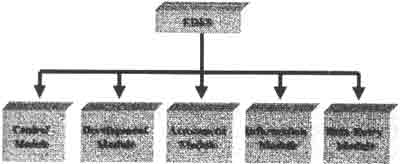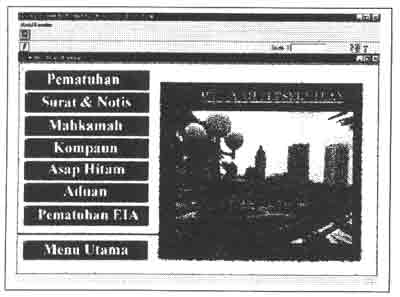| GISdevelopment.net ---> AARS ---> ACRS 1997 ---> GIS |
GIS Based Environmental
Decision Support System (EDSS)
Mohd. Idrus Mohd
Diah
Managing Director
IGD Hitech Corporation Sdn Bhd
Building 8, Unit 1-4, 1st Floor, Incubator Centre 1,
Technology Park Malaysia, 57000 Bukit Jail,
Kuala Lumpur, West Malaysia
Tel. - 603-9660203 Fax: - 603-9660206
E-mail :idrus@ig.pommy
Abstract
Managing Director
IGD Hitech Corporation Sdn Bhd
Building 8, Unit 1-4, 1st Floor, Incubator Centre 1,
Technology Park Malaysia, 57000 Bukit Jail,
Kuala Lumpur, West Malaysia
Tel. - 603-9660203 Fax: - 603-9660206
E-mail :idrus@ig.pommy
Environmental Decision Support System (EDSS) is a GIS based technology incorporating the multimedia, relational database u sing ArcView 3.0. A team of GIS professional at IGD Hitech CorporationSdn Bhd was selected to commission the development of EDSS Application in less than six months. EDSS contain pre-defined queries using user friendly Graphical User Interface (GUI) menus to support the functions carried out by agencies that have responsibilities in the area of environmental and pollution control. Each pre-defined query provides immediate information in multiple format (maps, satellite images attributes, pictures and video) to support the decision marking process and management of environment. EDSS shall be effectively implemented and applied for different levels and background of users at the Department of Environmental or any agency with similar functions. EDSS shall be applied and used not only on a stand-alone basis but also on a wide area network for a nationwide system.
1. Introduction
Geographical Information System (GIS) applications are developing rapidly. Thousands of new GIS-based systems have and are currently being installed, and many of these are already playing and important role in decision making at various levels, both in government and private organizations. Decision-making is a complex process, influenced by many factors, both human and non-human. A GIS application cannot make decision for people. However , GIS is able to provide many simulated results, which can help the decision-makers to achieve the decision and answer to some of these questions:-
- Where is the most polluted area in the Industrial Area and how much is the total.
- Where is the exact location of the polluted rivers and total of factory along the river.
- How many premises that violating the environmental
- Where are the projects that involve in Environmental Impact Assessment (EIA)
2. Environmental Decision Support System
As what have already been explained above. Environmental Decision Support System (EDSS) is a GIS based application. The main objective of this system is to apply a cost effective GIS technology in management, control and the development of natural resources aspects such as source of pollution and enforcement, air and water quality control, EIA, as well as compliance and complaint of pollution cases. EDSS is suitable for Department Of Environmental or any agencies whose business is related to the environmental. Figure 1.0 shows the main page of EDSS :-

Figure 1.0 The output screen of the main menu of EDSS
Development of EDSS
The development of EDSS is divided into two phases. This system was developed using PC Arc View 3. ArcInfo and also MS Access. The first phase of EDSS was more to designing the system, the database, and the spatial data for the base map using ArcInfo. The entire requirement and the assessment study were held together with the users of EDSS. In this phase, the development of Control module and also the Data-Entry Module was started. These two modules took about two months to complete. During the implementation, a few minor changes were made in order to comply with the user's requirement. The second phase of this system is the development of Assessment module, development Module and also the Information module. These three modules took about two months to complete, also with some changes made to comply with the user's requirements.
EDSS is a PC-Based system, which can also be expanded into a Client-Server system. The development was based on object-oriented programme technique, utilizing GUI technology, with the objective to produce a user-friendly system. This will reduce problems faced by inexperienced users and increase and learning curve for this system. Ultimately, this system is targeted towards users who have only the basic skills in handling computers. Figure 1.1 is the hierarchy of EDSS structure.

Figure 1.1 Hierarchy of EDSS structure
Implementation of EDSS
The analytical tools or EDSS are structured into five main modules. These five main modules are capable of providing the decision-makers with the tools and materials for them to make the decisions. The three main modules are :-
1. Assessment modules
The main objective of this module is to assess the activities of factories or development projects or premises, which is related to the environment. The decision-makers will visit these sites to see whether or not the onsite activities comply with the Environmental Quality Act. This module is also used to asses and evaluate new factories or development projects to determine their compliance with the Regulations. The decision-makers will not only evaluate and assess the development projects at the beginning but they will asses and also evaluate until the project is completed. As for the factories, the decision-makers will do the same assessment form time to time. By using this module, the decision-makers will know which factories or development projects or premises has not been visited more than the certain period of time. With just a simple query, the location of the factories, development projects or premises, will appear together with the detail of that factory. All of these detail will be used later in Control Module. There are four sub-modules, which supports the Assessment Module.
Figure 1.2 shows the output screen of Assessment Module

Figure 1.2 : - Output screen of Assessment Module
2. Control Module
This module is important to the decision-makers and it is used to control the activities of factories or any other premises that is under their surveillance. The main function of this module is to help the decision-makers identify factories that are violating the environmental and are not complying with the Environmental Quality Act. There are seven sub-modules supporting the module. All the seven sub-modules are also supporting each other. The sub modules are:-
- Sub-module Compliance-This sub-module helps the decision-makers to control the activities of the factories, development projects or premises. It also helps in identifying which factories, development projects or premises are not complying with the Regulations.
- Sub-module Legal Action- This sub-module is to see the factories,
development projects or premises for which Legal Action has been taken
upto them. All this data is auto-generated from the Compliance
sub-module. This sub-module allowed the decision-makers to make analysis
and queries and present it in visualized form, which can later be
printed. See figure 1.3.

Figure 1.3 -An example of an printing output
- Sub-module Letter of Notification -This sub-module has the similar function as the Legal Action sub-module. The decision makers will make decision based on their assessment in the Assessment Module.
- Sub-module Compound- This sub-module has it the similar function at the Legal Action and also the Letter of Notification sub-module. The decision-makers will make decision through their assessment in the Assessment Module. If the decision is to give the factory, the development project or the premise a compound ticket then the Compound data will be update appropriately.
- Sub-module Complaint- This sub module is used by the decision-makers to keep all the complains that have been received. They will keep all the complaints in
- one data base and also locate where the location of the factory or the development project or the premise that have complained is, which will be investigated at a later date.
- Sub-module EIA Compliance -This sub-module is meant for the factories, the development projects or the premises that is related to the EIA activities. This sub-module will give the decision-makers the information of the factories, the development projects or the premises that is not in compliance with the Regulation. Example includes not in compliance with the Scheduled Waste Management System or no EIA Consultant within the project resources. The decision-makers will see the location of the factories, development projects or premises through this system and at the same time will also be able to get detailed information on the related EIA activities being held.
- Sub-module Black Smoke Emission- -This sub-module helps the decision-makers to control the air quality. They will collaborate with the Road Transport Division to get the details that causes of the air pollution and they will study the causes in order to control the pollution level.

Figure 1.4:- Output screen of Control Menu

Figure 1.5:- Output screen of Location of the premises
3. Development Modules
The Development Module is the used to keep the data of courses and workshops for the staff. It is also used to keep track of the courses and workshops for the public. The features of this modules are entering the data, up-dating the data and print reports.
4. Data-entry Module
This module is for entering data. Data for Compliance Modules and also Control Modules is entered using this module.
These modules are all linked together with a GIS-based user interface, which provides graphics, dialog boxes, spatial analysis and many other functions.
EDSS implementation process can be divided into several stages. The first stage system study, where the overall system and workflow is defined from deriving the need and requirements of the user. The next stage will be looking at the installation of the system hardware followed by database definition and software installation. The third stage is the customization of the Control Module, which is the core module within the EDSS. This will take roughly around 2 to 3 months time. During the stage, users will get a chance to try out the system while changes were made to meet their needs. The following stage will look into the completion of software installation and customization, and the final stage is populating the database.
A typical configuration for the machine that EDSS will be running on will be a Pentium 100 with 32 MB RAM running on Windows 95. The space required within the hard disk for the application is about 40MB. The data base can be quite large and can consume the whole of a 2GB hard disk. However, for an enterprise implementation, there will be a lot more variables to be considered in determining the overall system configuration.
As this is a PC based system, the cost to implement this system is significantly cheaper them imp[lamenting a UNIX based solution. Furthermore, the trend today is towards multimedia and GUI based application. Thus, IGD believes that EDSS will have an immediate appeal to the users in terms of ease of use and value for money. Notwithstanding the fact that PC operating system does have some limitations compared to a multi-user UNIX environment, EDSS application an easily be converted to run on a UNIX workstation, as well as Window NT, thus giving it a flexibility of upgrade as well as technology investment protection for the client.
It is my believe that in the near future, automation will play an importation role in professional conduct to ensure optimum productivity with less cost. I believe that EDSS will be part of this future in the improvement of the decision-making process to support the overall objective of a more effective and efficient organization.